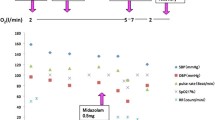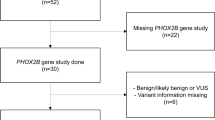Abstract
Background
Congenital Central Hypoventilation Syndrome (CCHS) is a rare condition combining respiratory hypoventilation with symptoms of autonomic dysregulation. Management of patients requires both medical and dental expertise to achieve a successful outcome. The aim of this paper is to present the dental management of a child diagnosed with CCHS, without pharmacological measures and in cooperation with medical expertise.
Case report
A 7-year-old girl was referred to a private dental practice with the chief complaints being pain and poor aesthetics. The child had been diagnosed with CCHS since infancy and had undergone several courses of medication. Although the patient was uncooperative, the paediatric pulmonologist advised against general anaesthesia. As a result, she was treated in the operating theater (OT) without sedatives, being monitored throughout the entire procedure. A total of eight primary teeth needed dental treatment (3 were restored, 4 were extracted and 1 was restored with a preformed metal crown). A mandibular lingual holding arch was placed, two weeks later.
Follow-up
The patient was seen after 6 months and 1 year. Her oral hygiene had improved significantly and her mother reported that the child ate better, brushed her teeth on a daily basis and was careful with dietary habits.
Conclusion
The collaboration between medical experts and a paediatric dentist was of crucial importance. The use of basic behaviour management techniques in conjunction with monitoring the patient’s vital signs led to a successful outcome and an improvement in the behaviour of the patient.





Similar content being viewed by others
References
American Academy of Pediatric Dentistry. Guideline on behavior guidance for the pediatric dental patient. Adopted by the American academy of pediatric dentistry clinical affairs committee—Behavior management subcommittee, 1990, revised 2011.
Antic NA, Malow BA, Lange N, et al. PHOX2B mutation-confirmed congenital central hypoventilation syndrome: presentation in adulthood. Am J Respir Crit Care Med. 2006;174:923–7.
Klingberg G. Dental anxiety and behaviour management problems in paediatric dentistry: a review of background factors and diagnostics. Eur Arch Paediatr Dent. 2007;8(4):11–5.
Marcus CL, Jansen MT, Poulsen MK, et al. Medical and psychosocial outcome of children with con- genital central hypoventilation syndrome. J Pediatr. 1991;119:888–9.
Mellins RB, Balfour HH Jr, Turino GM, Winters RW. Failure of automatic control of ventilation (Ondine’s curse). Report of an infant born with this syndrome and review of the literature. Medicine (Baltim). 1970;49:487–504.
Oren J, Kelly DH, Shannon DC. Long-term follow-up of children with congenital central hypoventilation syndrome. Pediatrics. 1987;80:375–80.
Pattyn A, Morin X, Cremer H, Goridis C, Brunet JF. Expression and interactions of the two closely related homeobox genes Phox2a and Phox2b during neurogenesis. Development. 1997;124:4065–75.
Pattyn A, Morin X, Cremer H, Goridis C, Brunet JF. The homeobox gene Phox2b is essential for the development of autonomic neural crest derivatives. Nature. 1999;399:366–70.
Shea SA, Andres LP, Shannon DC, Guz A, Banzett RB. Respiratory sensations in subjects who lack a ventilatory response to CO2. Respir Physiol. 1993;93:203–19.
Silvestri JM, Weese-Mayer DE, Nelson MN. Neuropsychologic abnormalities in children with congenital central hypoventilation syndrome. J Pediatr. 1992;120:388.
Todd ES, Weinberg SM, Berry-Kravis EM, et al. Facial phenotype in children and young adults with PHOX2B-determined congenital central hypoventilation syndrome: quantitative pattern of dysmorphology. Pediatr Res. 2006;59:39–45.
Weese-Mayer DE, Silvestri JM, Menzies LJ, et al. Congenital central hypoventilation syndrome: diagnosis, management, and long-term outcome in 32 children. J Pediatr. 1992;120:381–7.
Weese-Mayer DE, Shannon DC, Keens TG, Silvestri JM. Idiopathic congenital central hypoventilation syndrome: diagnosis and management. American thoracic society. Am J Respir Crit Care Med. 1999;160:368–73.
Weese-Mayer DE, Berry-Kravis EM, Zhou L. Adult identified with congenital central hypoventilation syndrome–mutation in PHOX2b gene and late-onset CHS. Am J Respir Crit Care Med. 2005;171:88.
Weese-Mayer DE, Berry-Kravis EM, Ceccherini I, et al. An official ATS clinical policy statement: congenital central hypoventilation syndrome: genetic basis, diagnosis, and management. Am J Respir Crit Care Med. 2010;181:626–44.
Zelko FA, Nelson MN, Leurgans SE, Berry-Kravis EM, Weese-Mayer DE. Congenital central hypoventilation syndrome: neurocognitive functioning in school age children. Pediatr Pulmonol. 2010;45:92–8.
Author information
Authors and Affiliations
Corresponding author
Rights and permissions
About this article
Cite this article
Boka, V., Lefkelidou, A. & Athanasiadou, E. Dental treatment of a child with congenital central hypoventilation syndrome. Eur Arch Paediatr Dent 17, 211–214 (2016). https://doi.org/10.1007/s40368-015-0213-9
Received:
Accepted:
Published:
Issue Date:
DOI: https://doi.org/10.1007/s40368-015-0213-9




